- Home
- Shore Fishing
- Pier Fishing Rigs
Pier Fishing Rigs and Tips
Shore anglers, drawn to piers like dogs to a lamp post, will find these pier fishing rigs and tips invaluable. Many such anglers use a pier purely as a opportunity to cast their bait into even deeper water - and in doing so, are completely missing the point.
Piers come in two varieties, the first of which is the solid type with concrete or masonry walls.
The other is the familiar open lattice type, supported on stilt-like piles driven deep into the seabed.
The relevance of this for pier fishermen is that the open type allows to the tide to flow through it relatively unimpeded, and the solid type prevents it from doing so. And each type presents us with unique fishing opportunities.
Piers, together with jetties and breakwaters, are mini reefs as far as a fish is concerned. Rich sources of both food and shelter, conditions which both fish and anglers will eagerly take advantage of - so don't expect to have it all to yourself!
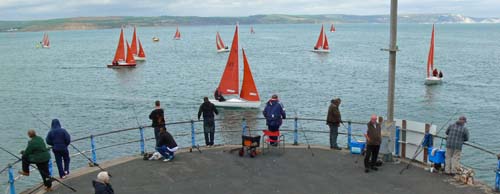
Pier Fishing Rigs, Tackle & Techniques
This is not the place for light tackle, as not only is there a real chance of having to bully a conger away from the pier structure, you may well have to lift its full weight. Main lines between 20lb and 30lb are not excessive - mono, not braid, as you'll need a bit of stretch to absorb your fish's attempts to shake himself free.
Reels can be either multipliers (US = baitcaster or traditional reel) or spinning reels, but robust enough for the heavy work. In fact, although not often seen in the UK, the Australian Alvey drum reel is ideal for pier fishing.
Rods shouldn't be too short for two reasons:~
- There needs to be enough of it projecting when leaning against the rail for bite detection;
- You'll need to pull a fish away from the structure, which is where his survival instincts will drive him.
Unlike the rod shown here, you should contrive some means of securing your rod to the pier railings, or it will slide off. And it's never a good idea to leave it unattended for long.
To Cast or Not To Cast?
Irrespective of what type of pier your fishing from, most often than not there's no need to cast at all - fish are always attracted to structures of any kind and chances are the fish will be directly below your rod tip.
In the case of a stilted pier, the tide will have gouged out depressions around the pier piles which will have joined up into a gully running up each side of the pier along its whole length. And it's here that most of the food particles end up, attracting crabs, sandeels, shrimps, pouting and other small baitfish - all of keen interest to the conger, bass, codling and flatfish that take up residence to take advantage of this well-stocked larder.
A solid pier will stop the tide in its tracks (well, not exactly - even Neptune couldn't do that), what I mean is that it will change its direction and cause it to flow, often very powerfully, along the wall. The turbulence at the foot of the wall will gouge out a gully in much the same way as the one found along stilted piles. Yes, another well-stocked larder.
So although the end of the pier will fish well at times, you're likely to do much better fishing in the gully halfway along it.
A Pier Fishing Rig for the Gully
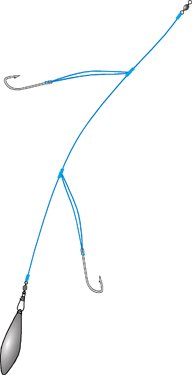 A simple paternoster rig
A simple paternoster rigWhatever bait you use - and peeler crab, mussel and worm baits are likely to be best - the fish will expect to find it right at the bottom of the gully, and it would be wise not to disappoint them. The best rig is a modified paternoster. The weight should be attached on a rotten bottom, with a flowing trace attached (by a dropper loop or bead-trapped swivel) a short distance above it. This should be around 3ft to 6ft long and be no lighter than the main reel line.
Of course you may be aware of a mussel bed or a patch of broken ground within casting range of the pier, and believe that your best chances are represented there. If so, you might want to remember that when casting from a pier built on piles - which of course allows the water to flow through it - it's always best to fish from the side that's facing into the oncoming tide. This way the flow will help keep your terminal tackle on the sea bed, rather than tending to lift it off. This may mean using a spiked lead to prevent it trundling downtide, much like you would in uptide ledgering from a boat.
Most anglers will choose standard beachcasting tackle - a 12ft to 13ft rod, a fixed spool or multiplier reel loaded with 12lb to 15lb mono line, and a lead of 4oz to 6oz and fish a one or two hook rig hard on the seabed. In view of the number of people around, all should be using a shock leader.
As a rule of thumb, the breaking strain of the shock leader (and it must always be mono for its stretch properties) should be ten times the weight of the lead (in ounces) in pounds, if you see what I mean. That is, for a 4oz weight use a 40lb shock leader, for a 6oz weight use a 60lb shock leader and so on.
And here's a tip ~ the shock leader should be longer than usual so that when you'll lifting a fish vertically up the pier, there's already a few turns of the heavier line on the reel.
Float Fishing
"Float Fishing?" I hear my American friends ask, "What's That?" It's what you guys call 'bobber fishing'.
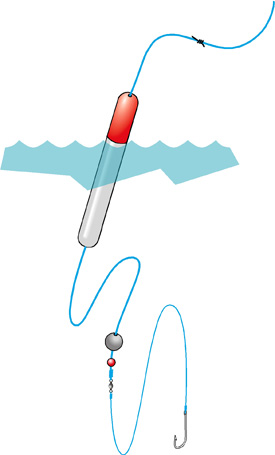 A saltwater float (bobber) rig
A saltwater float (bobber) rigYou won't need a shock leader for float fishing of course, but during the summer months this will be a popular pier fishing technique for mackerel, garfish and school bass in particular.
Bait your hook with of natural bait, a small sliver cut from the flanks of fresh mackerel or a short strip of squid.
Baitcasting and spinning methods don't readily lend themselves to pier fishing - you're just too far above the water to present the lure in a convincing manner.
Some Pier Fishing Tips...
Piers are social places, not just for tourists but for anglers too. We fish together in close proximity, with good banter and light-hearted conversation the order of the day.
Methods, baits and tackle are discussed, ideas exchanged and local knowledge freely exchanged - all of which is invaluable for the angler keen to learn more about pier fishing...
- When does this place fish best? On the flood tide or on the ebb?
- Do neap tides fish better than spring tides?
- What species are around at particular times of the year?
- Which are the best baits, and where can they be obtained?
Be There at the Right Time!
Two things affect a fish's feeding patterns more than any other:~
- The stage of the tide ~ Generally speaking, fishing is always best in the two hours coming up to high water and the two hours following high water - and all the more so if it's a spring tide. But the period of high water itself - when the tide is slack - is often not a prolific period at all.
- The time of day ~ Of course, fish don't check their watches (where would they wear one?) or sneak a look at the ornamental clock on the end of the pier, they take their cue from the prevailing light conditions. They're much less cautious in low light, which is why dawn and dusk are good times to fish.
So for the very best chance of making a good catch from the pier is to find a day when high water occurs at dusk or dawn, and plan your fishing session around that essential piece of data.
Know What's Happening With the Tide
All anglers, that's boat anglers and shore anglers alike should have a set of tide tables for their local fishing area. They are cheap, cheap, cheap - and so valuable...
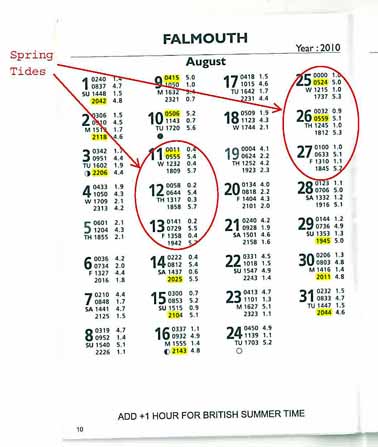
Let's say you want to plan a pier fishing session or two for the coming month - August in this example, at the port of Falmouth in the UK.
OK, I know there isn't a pier at Falmouth but, hey, give us a break...
The first thing to do is to mark the tides where high water falls around dawn or dusk. Here, I've highlighted these in yellow.
Next identify the periods of spring tides, as encircled here. They occur every 14 days or so, with the corresponding neap tides midway in between.
Spring tides occur when the sun, moon and earth are in line, and the sun and moon's gravitational forces work in unison to create the maximum tides on earth.
You can see how this works here...
Spring tides always occur a day or two after a full moon and a new moon, and these are usually shown by a blacked-in circle (for a full moon) and an empty circle (new moon) as shown here on the 10th and 24th August.
If one or more of your dusk/dawn tides falls within a spring tide range, your chances of a good catch are probably at their highest. The early morning high tides on 25th and 26th August look promising...
Which Side of the Pier to Fish?
Many anglers favour the downtide side, as it holds your terminal tackle away from the pier, removing any chance of it being swept under it. Convenient yes, but will fishing this side improve your chances of a good catch? No. The side facing into the tide is the one to fish. On this uptide side, scent from your bait will be swept into and along the gully where the fish will detect it - and the tide will hold your sinker firmly on the seabed, rather that getting under and dislodging it as it would on the downtide side.
When the tide is flowing strongly against a solid pier, there will often be an eddy created at the end of the pier on the downtide side. Providing there's not too many pier fishermen already at it, this will be a great spot to explore with float tackle. Expect mackerel to take an interest...
Landing your Catch
Having hooked your fish you've now got to get him up onto the pier.
One solution is to use a drop net for pier fishing, but if you don't have one you'll have to crank him vertically up and over the pier rail - and it's here that many a pier-caught fish regains its freedom, particularly if it's a good-sized one.
Another solution? Use a heavy mono leader, long enough to reach from the sea surface whilst having a few turns already on your reel - and hope that your hook holds.
Don't buy the special mono leader line for this - that's intentionally low-stretch for surf casting use - ordinary, stretchy nylon monofilament line is what you want. But a drop net is far safer...
How to Attract Fish to your Bait
We call it 'groundbaiting' here in the UK. You over there in the USA call it 'chumming'. Either way, it can make a real difference to your catch rate when pier fishing.
All you need is a mesh bag, enough cord to enable the bag to reach from the seabed when tied to the pier rail, a lead weight (or a large pebble) to keep the bag in position - and some chum.
The whole idea behind chumming is to create an oily slick and trail of food particles back to the chum bag, which is of course close to your baited hook. So the chum is best made up from mashed fish - oily ones like mackerel are best, crushed shore crabs, fish guts and heads from an earlier catch, bread and pilchard oil all mixed up into a paste. Doesn't that look appetising? You could almost take a bite out of it yourself.
The holes in the mesh bag shouldn't be so large to allow the chum to wash out of it too quickly, or too small to prevent the small free samples from escaping either. I'll leave you to decide what 'just right' is. Lower the whole shebang close to the seabed near your baited hook and await developments. Shouldn't be too long to wait, but give it a jiggle now and again to get things moving.
Don't Lose Your Pier Fishing Rod!
More than a few pier anglers' final view of their pier fishing rod and reel has been of it cartwheeling over the pier rail and vanishing forever into the depths below, leaving them brooding mournfully over the size of the fish that stole it.
One way of reducing the chance of this happening is to make sure there's not more than about a third of the fishing rod length projecting over the rail.
And many a pier fishing rod has been damaged (particularly the rod rings) as it slides sideways off the rail in a gust of wind, or a moment of carelessness.
Recent Articles
-
Sea Fishing Rods and Reels Must Be Compatible for a Balanced Outfit
Mar 08, 21 08:30 AM
A quality reel fitted to a quality rod doesn't necessarily make it a quality outfit. Your fishing rods and reels have to be properly matched if you're to get the best out of them, and here’s how -
Essential Lure Fishing Tips That All Saltwater Anglers Should Know
Mar 08, 21 04:51 AM
Which single lure fishing tip applies to trolling, jigging, baitcasting, spinning, fly fishing and any other branch of lure fishing? Well, it is the one at the top of this list -
Vital Jig Fishing Tips That You Really Cannot Afford To Miss!
Mar 07, 21 10:20 AM
Essential jig fishing tips to help you select the right lure for successful jig fishing, together with the techniques required to get the most out of your jig fishing outfit
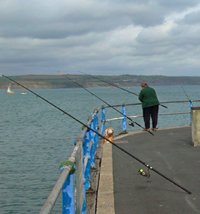
























New! Comments
Have your say about what you've just read! Leave me a comment in the box below.